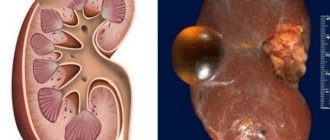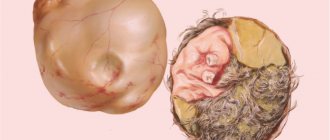Signs and symptoms
Lack of menstruation
Amenorrhea is characterized by the complete absence of menstruation. Other glitches in their schedule paint a different picture.
Discomfort or abdominal pain
Inflammatory diseases, changes in the ovaries, fibroids not only cause the absence of menstruation, but are also accompanied by pain. These manifestations facilitate diagnosis.
General malaise
Weakness, sweating, mood swings, irritability. These symptoms are caused by a hormone imbalance.
Deepening of the voice
A woman’s body begins to overproduce the male hormone testosterone, which gives her masculine characteristics.
Weight change
A woman may lose weight or gain weight sharply. It all depends on the reason that caused amenorrhea.
Change in hair density
This is excess hair growth or hair loss, especially in the armpits and pubic area, which is characteristic of amenorrhea caused by a malfunction of the hypothalamus.
Treatment
Photo: opt-611422.ssl.1c-bitrix-cdn.ru
Amenorrhea is a complex disease, so its treatment is usually lengthy and varied. The treatment tactics for this pathology should be selected by a gynecologist depending on the cause of the disease.
So, if the cause of the disease is infantilism of the reproductive system, then the emphasis in treatment is on a special diet and taking hormonal drugs. This leads to the woman rapidly gaining the missing fat and muscle tissue over the course of several months.
If amenorrhea is caused by developmental defects, doctors may prescribe surgical treatment.
If a woman has a secondary form of the disease, treatment of amenorrhea must necessarily include eliminating the cause that caused it. This often requires changing your diet or avoiding stressful situations.
For ovarian pathologies, doctors prescribe hormone replacement therapy. It is carried out only under the careful supervision of a specialist. During the entire treatment period, a woman should undergo hormone tests from time to time.
All types of amenorrhea, regardless of the reasons that caused it, require treatment. The only exception in this case may be lactational amenorrhea, since six months after childbirth the menstrual cycle begins to improve. Until this time, a woman can use the lactational amenorrhea method (if used correctly, its reliability can reach 98%).
In general, treatment for amenorrhea almost always includes:
- hydro- and physiotherapy;
- massage;
- physical therapy;
- performing hardening procedures;
- treatment with folk remedies;
- diet correction;
- taking vitamin and mineral complexes.
The best results are usually achieved by combining several treatment methods.
If a patient’s amenorrhea is a consequence of unfavorable psychogenic factors, doctors may additionally prescribe:
- psychotherapy sessions;
- oxygen therapy or yoga;
- general strengthening procedures.
It is worth noting that amenorrhea can only be cured by knowing the causes of its occurrence. And this can take a lot of time even for experienced doctors. That is why treating amenorrhea at home is unacceptable.
Homeopathy
Homeopathic medicines have a completely natural composition, but they are much more effective than conventional herbs. Doctors often prescribe them in addition to medications.
Treatment of amenorrhea with homeopathy is most often used if the disease was caused by chronic stress or severe emotional stress. For this purpose, homeopathic preparations with a sedative effect are used.
However, homeopathic remedies can be helpful for all types of amenorrhea. This is especially true for homeopathic remedies with hormonal effects. They bring the greatest benefit in the treatment of hypogonadotropic amenorrhea.
However, only a doctor should choose these drugs and prescribe their dosage based on the patient’s indications and contraindications.
Massage
Today, to eliminate the disease, many reputable doctors recommend that patients undergo massage for amenorrhea. The essence of this massage is to create vibrations in the area of the lumbar vertebrae. In this way, the nerve endings in this area are irritated, which ultimately has a stimulating effect on the reproductive organs.
Such a massage can help normalize menstrual function and ripen the genital organs.
To improve blood circulation in the pelvic organs, doctors may also perform tapping movements on either side of the lower spine.
Numerous positive reviews from patients about this procedure indicate its high effectiveness.
Diet
Diet for amenorrhea is of great importance. However, it should directly depend on the causes of the disease. So, if the cause of amenorrhea in a patient is fasting, then a high-calorie diet is indicated for her, and if the pathology is caused by Itsenko-Cushing's disease, the amount of food consumed, on the contrary, should be reduced.
However, no matter what the diet, nutrition during amenorrhea should always be complete, that is, a woman should not consume vitamins, fats, proteins, carbohydrates in quantities less than the daily norm.
With amenorrhea, it is very important to normalize the patient’s weight, since menstruation cannot proceed normally both with excess weight and with underweight.
To restore the functioning of the reproductive organs, it is also necessary to stop drinking alcohol and cigarettes, and normalize work and rest patterns.
Causes
There are two groups of reasons that cause amenorrhea.
Physiological reasons
In these situations, there are no disturbances in the functioning of the body.
Pregnancy
During pregnancy, menstruation stops because it is no longer necessary. Everyone knows about this.
Lactation
Feeding a child up to six times a day for a year guarantees the absence of pregnancy by 98%. Lactation promotes the production of hormones that suppress ovulation.
Pathological causes
In this case, we are talking specifically about malfunctions in the body.
Stress
Nervous tension affects the production of hormones that regulate the menstrual cycle. With prolonged severe stress, ovulation may disappear completely.
Heavy physical activity
A woman's body is not designed to perform hard work and excessive sports. Otherwise, not only amenorrhea may occur, but also uterine prolapse, for example.
Endocrine disorders
Disorders of the pituitary gland or hypothalamus
Sometimes the symptoms of a disease appear in one place, but its cause lies in a completely different place. Thus, the cause of amenorrhea may be a tumor of the pituitary gland, a part of the brain that produces a hormone that regulates the menstrual cycle.
Gynecologists carry out unsuccessful treatment, precious time is lost, and the patient gets worse.
Thyroid diseases
An imbalance of thyroid-stimulating hormones entails changes in the functioning of the reproductive system. Sometimes manifestations of malfunctions of the thyroid gland are mistaken for early menopause and time is wasted for therapy.
Inflammatory processes
A woman's genitourinary system is extremely vulnerable to infections. Intracellular pathogens are especially dangerous: chlamydia, mycoplasma, ureaplasma, since they can cause asymptomatic diseases.
Amenorrhea: description
Doctors call amenorrhea the absence of menstruation. This is natural during pregnancy and breastfeeding. During menopause, the maturation of the egg is depleted, which also leads to a gradual decrease in the activity of the cycle until there is no period at all.
Apart from these natural causes of amenorrhea, missing a period can be the result of an illness or disorder. Here, doctors distinguish between so-called primary amenorrhea , in which a woman has not had menstruation until age 16, and secondary amenorrhea . With secondary amenorrhea, women already had normal cycle activity. Secondary amenorrhea is when there is no menstrual period for more than three months.
Diagnostics
Consultation with a gynecologist
The doctor must collect information about diseases, lifestyle, heredity, assess the ratio of the patient’s height and weight, and also conduct an examination in a gynecological chair. In some cases, amenorrhea has characteristic symptoms, such as pupil syndrome.
The choice of other diagnostic measures depends on the suspected cause of amenorrhea.
Blood tests
This study allows us to determine the following:
- levels of follicle-stimulating and luteinizing hormone;
- thyroid hormone levels;
- prolactin level;
- the presence of antibodies to pathogens of infectious diseases, for example, chlamydia.
Doppler ultrasound of the pelvic organs
The method helps to establish the fact of cystic ovarian degeneration and see other anomalies. It is important to contact a qualified specialist, since ultrasound examination is one of the most operator-dependent studies.
MRI of the brain
The method is used when a malfunction of the pituitary gland is suspected. It should not be used unless necessary.
Amenorrhea in women: causes
Amenorrhea in women: causes
The development of amenorrhea is due to the influence of many factors of a diverse nature. As a rule, primary amenorrhea occurs in the following cases:
- Congenital defects in the development of the uterus: fusion of the cavity, absence of the reproductive organ. Features of the anatomical structure can interfere with the outflow of blood and lead to the development of false amenorrhea.
- Genetic mutations . Changes that occur at the gene level disrupt the functioning of individual structures of the reproductive system and disrupt the timing of puberty.
- Ovarian resistance . This is an innate property of the ovaries not to respond to control signals sent by the pituitary gland.
- Insufficient activity of the pituitary gland . As a rule, such a problem develops long before the onset of puberty.
Lack of active interaction between the pituitary gland and hypothalamus, disruption of the regulatory system based on their feedback. It can also cause amenorrhea in women.
Treatment options for amenorrhea
Medications
The choice of medication depends on the identified cause. In case of polycystic changes in the ovaries, hormonal drugs are needed, in case of neuroses - sedatives, in case of malfunctions of the thyroid gland - medications aimed at correcting its functioning, fibroids require surgical intervention, malfunctions in the pituitary gland - the patient is managed by a neurologist.
Complementary and alternative treatments
These measures should be used only after consultation with a doctor, since they also have contraindications and interact with essential drugs, which can lead to undesirable consequences.
Secondary amenorrhea
Amenorrhea is a delay or complete absence of menstruation in girls or women. This process can be either normal physiological or a severe pathology. The absence of menstruation during a certain age period (up to 14 years for girls and after 45 years for women) and during pregnancy is considered a normal condition of the reproductive system that does not require treatment. (more about this in the article “Amenorrhea”)
Severe menstrual irregularities include secondary amenorrhea, which can cause infertility. Amenorrhea can also be called “lack of ovulation.” This disease is characterized by the fact that menstruation stops coming in women with a normal menstrual cycle. If menstruation is absent for more than 6 months, then this is already considered secondary amenorrhea.
Causes of secondary amenorrhea
Often secondary amenorrhea can develop as a complication after adnexitis. Chronic adnexitis is a disease of the appendages, learn more about this disease by clicking on the link
There are many factors that can affect the regularity of the menstrual cycle and cause irregularities. As a rule, it can be not one, but several at once, and therefore it is very difficult to determine the cause of amenorrhea and prescribe treatment. This requires a complete examination of the entire body.
- Hormonal imbalance, which manifests itself as a pathological condition of the ovaries, pituitary gland or thyroid gland . Hormones are produced in incorrect proportions or are completely absent, which leads to irregular menstruation .
[ads-pc-1]
Hormonal drugs can become one of the causes of disruption of normal hormonal levels, which lead to the absence of menstruation, but this condition is not considered a pathology.
- Stressful situations also lead to irregularities in the menstrual cycle, but it improves after the situation becomes stable again.
- The causes of secondary amenorrhea, which is a normal condition of a woman’s body, include periods of pregnancy and breastfeeding.
- One of the serious causes of amenorrhea is the formation of cysts on the surface or cavity of the ovaries. As a result, the ovaries cannot fulfill their intended purpose; in this case, male hormones significantly predominate over female hormones. In a word, the egg cannot mature.
- Inadequate, poor nutrition or overeating also leads to delayed menstruation. Excess weight or, on the contrary, anorexia leads to serious consequences, including reproductive fiction. Menstruation occurs only after weight normalization.
- More serious causes include a number of gynecological diseases, namely:
- Adhesive process in the uterine cavity. Adhesions, so-called synechiae, occur as a result of turnover, childbirth or diagnostic examination of the uterus. As a rule, this leads to infertility because the uterus becomes obstructed due to adhesions.
- Polycystic ovary syndrome is another serious problem that leads to amenorrhea and infertility. The ovary cannot produce the required amount of hormones to participate in fertilization. This disease is treated only surgically, removing polyps from the ovary.
- The onset of menopause is earlier than 50 years. The principle of amenorrhea in this case has not been studied. It is generally accepted that these are the consequences of genetic predisposition.
Among other things, heavy physical exertion and professional sports can also lead to menstruation irregularities, which are restored after the cessation of this type.
Despite the fact that amenorrhea can occur as a result of many diseases, clinically it manifests itself in exactly the same way. The absence of menstruation for more than six months is the first and most important sign of menstrual irregularity, but it is not the only one.
Symptoms of secondary type amenorrhea
- Women with menstrual irregularities begin to rapidly gain weight or, conversely, lose a lot of weight. This is due to the stress that the body experiences as a result of amenorrhea. Another reason for excess weight or excessive thinness can be a hormonal disorder in the body, which is the absence of menstruation. Excess or lack of hormones leads to problems with a woman’s weight.
- Psycho-emotional disorders, which manifest themselves in the form of severe depression, sudden changes in mood, aggressiveness, irritability and tearfulness. Infertility, which develops against the background of the absence of menstruation, only aggravates the general emotional state of a woman. During this period you need to be especially attentive to her.
- The predominance of the male hormone in a woman’s body – testosterone, which manifests itself in the form of a change in voice (becomes rougher), sweating, increased hair growth. It is worth noting about hair that it begins to grow not only more intensively, but also in places where it did not grow before . For example, above the upper lip, near the nipples, etc. The main symptom of secondary amenorrhea is galactorrhea. In a word, a pregnant and lactating woman also does not have periods, but this is a normal physiological process and the endocrine system is triggered to produce milk for the baby. With secondary amenorrhea, a false signal is triggered, since menstruation is also absent, as with the physiological process during pregnancy and lactation.
- Symptoms appear the same as during menopause . This manifests itself in the form of: a sharp change in body temperature (either fever or chills), arrhythmia and tachycardia (heart rhythm disturbances), osteoporosis, loss of libido (lack of desire to have sex), sleep disturbances, etc. It is considered one of the very difficult conditions not only psychologically, but also physiologically .
- Decreased desire to have sex. This condition only aggravates the woman’s depressive state. Everyone knows that good sex can bring joy and increase self-esteem, but even here a woman with menstrual irregularities does not receive self-satisfaction.
In addition to these symptoms, there are those signs that are accompanied by the presence of chronic diseases. For example, clinical manifestations of one of the causes of amenorrhea, polycystic ovary syndrome.
[ads-pc-2]
In any case, the sooner treatment is started, the more effective it will be. It is believed that curing secondary amenorrhea is extremely difficult. This requires an integrated approach and solving problems from several body systems at once: endocrine, reproductive functions. In addition, there may be disorders at the genetic level. Mandatory observation and consultation with a psychologist is required.
Treatment of secondary amenorrhea
- First of all, it is necessary to restore balance emotionally. Establish the correct diet, day and rest. Incorporate into daily physical activity.
- If amenorrhea develops against the background of hormonal disorders, then consultation with an endocrinologist is required . In this case, the woman needs to undergo hormone tests, on the basis of which the attending physician will prescribe therapy. It is necessary to correct hormonal levels, since the result of the study may turn out that there is an excess of some hormones in the body, and some, on the contrary, are lacking.
- If amenorrhea occurs as a result of gynecological diseases, then treatment of these pathological conditions is necessary first. For example, if there are cysts in the ovary, their removal and hormonal correction of those hormones are necessary. An ovary with cysts in it cannot fully perform its functions.
- To treat depression and menopausal symptoms, patients are prescribed sedatives in combination with other medications. In more severe cases, antidepressants are already used.
- Surgical methods for treating amenorrhea are used in the presence of various benign or malignant neoplasms.
- During the recovery period, physiotherapy is additionally prescribed. Electrophoresis with drugs such as novocaine, zinc or thiamine allows you to normalize metabolism and restore menstruation. It is applied directly to the location of the pituitary gland and hypothalamus. They are prescribed in small courses with a short duration. What drug to use when carrying out. The doctor decides its duration.
[ads-pc-3]
Secondary amenorrhea occurs against the background of any disorders and all treatment is aimed at eliminating them. Lack of a regular menstrual cycle can lead to infertility and therefore it is necessary to strictly monitor the regularity of menstruation. The absence of menstruation for more than 6 months should not be ignored. The main method of early detection of the disease is considered to be regular visits to the gynecologist, namely at least 1 – 2 times every six months. At the slightest suspicion of this pathology, the doctor may additionally refer you for an ultrasound, which allows you to see whether there are cysts in the ovaries, the condition of the endometrium,
In order to prevent this disease, it is not recommended to have a promiscuous sex life, but to eat right and lead an active lifestyle. It is very important to monitor your body weight. Excess weight is the cause of many diseases, including emotional ones. Prevention of amenorrhea is also prevention of future infertility, which is very difficult to treat.
Lactational amenorrhea
This is a special type of menstrual irregularities, which is not a pathology and does not indicate any disease in a woman’s body.
Lactational amenorrhea occurs during the period of breastfeeding, but under the obligatory condition that the child receives exclusively mother’s milk for food, without supplementing with water, supplementary feeding and complementary foods, and also in the absence of a long period without feeding (that is, the woman feeds the baby on demand and although 1-2 times during the night).
Constant sucking of the mother's breast by the child suppresses ovulation in her body, which means it disrupts the menstrual cycle, preventing pregnancy. This is a reliable, simple, without side effects, physiological method of contraception, the effectiveness of which, however, sharply decreases from the moment other foods are introduced into the child’s diet (after six months).
Questions and answers from a doctor
1) At the age of 14, my periods stopped after a sudden weight loss. I gained weight and my periods returned. Now I want to get pregnant, but I can’t. Could this be a consequence of amenorrhea?
- Every woman has a chance of becoming infertile; this is not necessarily associated with amenorrhea in the past. Another thing is sudden weight loss for no reason - it may indicate the presence of endocrine diseases that prevent you from getting pregnant. You should consult a gynecologist if you cannot become pregnant within one year of regular unprotected sexual activity.
2) My period started, but the next day it stopped, after that I haven’t had a period for a month. What could it be?
- Take a pregnancy test, this may indicate a threat of early miscarriage or ovarian dysfunction. In any case, you need to go to the gynecologist.
3) How long does amenorrhea last after childbirth?
- Depends on whether you are breastfeeding. For non-breastfeeding women, the menstrual cycle can resume within 6-8 months, and for breastfeeding women, after a few months or even a year. This is all a variant of the norm.
4) I am 38 years old, I haven’t had my period for a year now. The signs of menopause don’t bother me, I don’t want to give birth. Do I need treatment?
- It is necessary to undergo treatment. Early menopause can lead to serious illnesses.
5) I have polycystic ovary syndrome. I have been unsuccessfully being treated for infertility with hormones for several years, but there is no effect, what should I do?
- Most likely, you are indicated for surgical stimulation of ovulation or you need to resort to artificial insemination. In any case, the treatment tactics should be determined by your attending physician.
6) I’m 16 years old, but I still don’t have periods. Can I have sex?
- It is possible, but it is also necessary to visit a gynecologist and find out the reason for the lack of menstruation.
7) Can amenorrhea occur from long-term use of hormonal contraceptives?
- Yes maybe. This is a rare side effect of hormonal contraceptives when ovarian hyperinhibition syndrome develops. It is necessary to stop taking hormones; menstrual function will recover on its own a few months after discontinuation.
 Is it possible to get pregnant during lactation if there are no periods?
Is it possible to get pregnant during lactation if there are no periods?
- Lactational amenorrhea is an unreliable method of contraception, so pregnancy is possible even if you have not yet menstruated.
Causes of amenorrhea
It is impossible to name one reason for the absence of menstrual bleeding for all women. Each patient has individual factors that provoke the disease. Amenorrhea leads to:
- taking hormones (in particular, steroids);
- heavy sports;
- stress;
- strict diets, raw food diet and other non-standard types of nutrition;
- unhealthy lifestyle and bad habits.
Amenorrhea occurs after a hysterectomy (complete removal of the uterus). In this case, they talk about the iatrogenic nature of the pathology.
Diagnostic methods
To prescribe effective treatment for amenorrhea, it is necessary to establish the cause of the disorders. In the absence of menstruation, a comprehensive diagnosis is required , which consists of several stages. Determining the causes includes a different sequence of actions:
- Interview and collection of obstetric history. The doctor needs to know whether the patient has previously had menstruation and how regular they were. All past illnesses, surgical interventions, pregnancies and abortions are important.
- Inspection. A bimanual examination on a chair allows you to determine the position of the uterus and appendages, examine the cervix and exclude underlying diseases. The doctor determines whether the uterus is normal size.
- Ultrasound. Ultrasound scanning gives a more clear picture of the condition of the pelvic organs. The specialist examines the layers of the reproductive organ, determines their correspondence to any phase of the cycle, measures the ovaries and evaluates their functionality. An ultrasound can also give a preliminary assessment of the ovarian reserve.
- Hysteroscopy. Instrumental manipulation is performed in a hospital and requires pain relief. During the procedure, a miniature optical system is inserted into the woman's uterus, which transmits an image to a screen. Diagnostics allows you to examine the surface of the endometrium in detail and, if necessary, take biomaterial for a biopsy.
- Blood test for hormones. In the diagnosis of menstrual dysfunction, great importance is given to hormonal levels. For amenorrhea, a blood test is prescribed to determine the level of estrogen and progesterone, prolactin, 17-OH progesterone, testosterone, androgens, and anti-Mullerian hormone.
- MRI of the head. Since the pathology may be caused by changes in the hypothalamus, it is important to determine its condition. For this, computed or magnetic resonance imaging of the brain is recommended, for example, at the MRI diagnostic center of the LDC MIBS.
The results of the initial examinations set the vector for further actions. A woman with amenorrhea undergoes laparoscopy, is examined for infections, undergoes ovarian resection, diagnostic curettage and other medical procedures at a gynecologist, for example, at the GMS Moscow clinic.
Amenorrhea: what is it?
Amenorrhea is a persistent disturbance of menstrual function, which is accompanied by the absence of bleeding for six months or longer. In ICD-10, the disease is assigned code N91 , and depending on the nature of the disease, additional labels are assigned.
The main difference between secondary amenorrhea and other types of absence of menstrual bleeding is a normal cycle history. This means that the woman used to have menstrual bleeding, but for some reason she is now absent. This condition is detected much more often than other forms of the disease. This condition distinguishes amenorrhea in a fully developed woman from patients with underdevelopment of the genital organs or congenital absence of the uterus.
Symptoms
In fact, there is only one symptom - the absence of menstruation, accompanied by:
- Complaints about being overweight. It causes disruptions in the hormonal structure of the body. Increased sweating, voice changes and increased hair growth are all due to high testosterone levels.
- In addition, milk discharge from the mammary glands can be observed, even though the woman is not expecting a child.
- Women may complain of headaches, weakness, irritability and drowsiness.
Primary amenorrhea
Primary amenorrhea is detected in approximately 3% of women of reproductive age. A distinctive feature of this disorder is the absolute absence of menstruation . In other words, a girl does not go through menarche or experience monthly bleeding during puberty. In this case, the development of secondary sexual characteristics can be timely or late. Usually this symptom makes parents worry about their daughter’s condition and consult a doctor.
Primary amenorrhea is difficult to treat. This symptom often indicates severe endocrine disorders, congenital anomalies and other irreversible pathologies. Primary amenorrhea is most often detected at the age of 16-20 years; less often, the disease is diagnosed in patients over 25 years of age.











